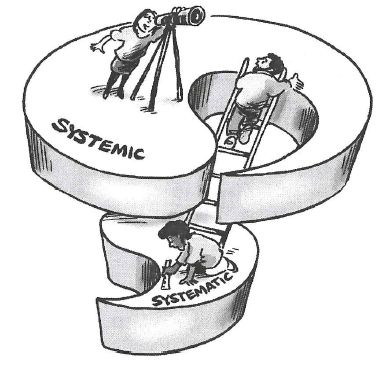5 Distinctions between systemic and systematic practice
A tension has existed throughout the history of Western thought around whether to focus on parts or the whole. The practice that springs from this history carries the same tension. This tension has been particularly visible within science and philosophy for a long time and it gives rise to different approaches.
Emphasising the parts has been called mechanistic, reductionist or atomistic. An emphasis on the whole has been called holistic, organismic or ecological. As Fritjof Capra (1996) notes: ‘In twentieth century science the holistic perspective has become known as “systemic” and the way of thinking it implies as “systems thinking”.’ Capra also claims systems thinking is ‘contextual’ thinking; and since explaining things in their context means explaining them in relation to their environment, I can also say all systems thinking is environmental thinking.
Two adjectives arise from the word ‘system’. Systemic thinking, thinking in terms of wholes, may be contrasted with systematic thinking, which is linear, step-by-step thinking. Likewise, it is possible to recognise systemic practice and systematic practice.
Table 1 summarises some of the characteristics that distinguish between systemic and systematic thinking and action and you should study this carefully. You will return to many of these characteristics in the coming weeks.
Both systematic thinking and systemic thinking have their place. I am not in any way trying to set up an idea that systemic is good, systematic is bad. They are not in opposition in the hands of an aware practitioner and can be complementary in dealing with complex situations (a topic you will return to in Week 7). My own perspective, when managing or intervening in complex situations is that it is usually more appropriate to approach the task systemically. In other words, systemic thinking provides the context for systematic thinking and action. Thus my ideal, aware, systems practitioner is one who is able to distinguish between systemic and systematic thinking and is able to embody these distinctions in practice. This has implications for the initial starting conditions for any form of purposeful action – i.e. do I start out systemically or systematically?

Of course, I am building an ideal model and day-to-day experience is different from this. No person can expect to become or embody that ideal overnight. It requires active engagement in a process of experiential learning. The other point I wish to make is that I am not equating the systems practitioner role with someone who is a professional consultant. This is a possible role, but in my idealised model the systems practitioner is anyone seriously interested in understanding and taking action in any context (although I return to this issue in Week 8).
| Systematic thinking | Systemic thinking |
| The whole can be understood by considering just the parts through linear cause-effect mechanisms. | Properties of the whole differ, they are said to emerge from their parts; e.g. the wetness of water cannot be understood in terms of hydrogen and oxygen. |
| Systems exist as concrete entities; there is a correspondence between the description and the described phenomenon. | Boundaries of systems are determined by the perspectives of those who participate in formulating them. The result is a system of interest. |
| Perspective is not important. | Individuals hold partial perspectives of the whole; when combined, these provide multiple partial perspectives. |
| Analysis is linear. | Systems are characterised by feedback; may be negative, i.e. compensatory or balancing; or positive, i.e. exaggerating or reinforcing. |
| A situation can be understood by step-by-step analysis followed by evaluation and repetition of the original analysis. | Systems cannot be understood by analysis of the component parts. The properties of the parts are not intrinsic properties, but can be understood only within the context of the larger whole through studying the interconnections. |
| Concentrates on basic building blocks. | Concentrates on basic principles of organisation. |
| There is a foundation on which the parts can be understood. | Systems are nested within other systems – they are multi-layered and interconnect to form networks. |
| Analytical. | Contextual. |
| Concerned with entities and properties. | Concerned with process. |
| The system can be reconstructed after studying the components. | The properties of the whole system are destroyed when the system is dissected, either physically or theoretically, into isolated elements. |
| Systematic action | Systemic action |
| The espoused role of the decision-maker is that of participant‑observer. In practice, however, the decision-maker claims to be objective and thus remains ‘outside’ the system being studied. | The espoused role and the action of the decision-maker is very much part of an interacting ecology of systems. How the researcher perceives the situation is critical to the system being studied. The role is that of participant‑conceptualiser. |
| Ethics and values are not addressed as a central theme. They are not integrated into the change process; the researcher takes an objective stance. | Ethics are perceived as being multi-levelled as are the levels of systems themselves. What might be good at one level might be bad at another. Responsibility replaces objectivity in whole‑systems ethics. |
| The system being studied is seen as distinct from its environment. It may be spoken of in open system terms but intervention is performed as though it were a closed system. | It is the interaction of the practitioner and a system of interest with its context (its environment) that is the main focus of exploration and change. |
| Perception and action are based on a belief in a ‘real world’; a world of discrete entities that have meaning in and of themselves. | Perception and action are based on experience of the world, especially on the experience of patterns that connect entities and the meaning generated by viewing events in their contexts. |
| Traditions of understanding may not be questioned although the method of analysis may be evaluated. | There is an attempt to stand back and explore the traditions of understanding in which the practitioner is immersed. |
